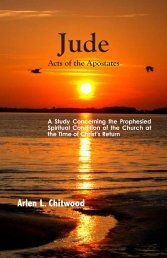Signs in John's Gospel - The Lamp Broadcast
Signs in John's Gospel - The Lamp Broadcast
Signs in John's Gospel - The Lamp Broadcast
You also want an ePaper? Increase the reach of your titles
YUMPU automatically turns print PDFs into web optimized ePapers that Google loves.
Except a Man… (III) 107<br />
flesh; and, apart from the Son, life does not exist (vv. 1, 2; cf. John<br />
1:1-4a, 14; I John 5:12). A person either has “fellowship” with the<br />
Father and with His Son or he doesn’t. “God is light, and <strong>in</strong> him<br />
is no darkness at all.” (v. 5b; cf. John 1:4b, 5). And a person either<br />
walks <strong>in</strong> the light and experiences fellowship with the Father and<br />
with His Son or he walks <strong>in</strong> darkness and does not experience this<br />
fellowship (vv. 3-7). Middle grounds do not exist at any po<strong>in</strong>t <strong>in</strong><br />
the preced<strong>in</strong>g, or elsewhere <strong>in</strong> I John, or elsewhere <strong>in</strong> Scripture <strong>in</strong><br />
contrasts of this nature.<br />
And understand<strong>in</strong>g that contrasts of this nature are seen over<br />
and over <strong>in</strong> I John will help one to not only better understand why<br />
the Spirit moved John to use the expression “brought forth out of<br />
God” ten times <strong>in</strong> this short epistle but also why sharp contrasts<br />
are seen every time this expression is used.<br />
2) “Brought Forth out of God”<br />
John’s first use of this expression <strong>in</strong> his first epistle is <strong>in</strong> 2:29.<br />
In the context lead<strong>in</strong>g <strong>in</strong>to this verse, reference is made to “little<br />
children” (v. 28), which, <strong>in</strong> the light of the overall text and verses<br />
such as Matt. 18:3 and Rom. 8:14-23, can only be an allusion to<br />
<strong>in</strong>dividuals undergo<strong>in</strong>g the child-tra<strong>in</strong><strong>in</strong>g as sons seen <strong>in</strong> Heb. 12:5-<br />
8. And this tra<strong>in</strong><strong>in</strong>g, which is with a view to not be<strong>in</strong>g “ashamed<br />
before him at his com<strong>in</strong>g,” will allow <strong>in</strong>dividuals to be among<br />
those one day adopted as firstborn sons, who will subsequently<br />
occupy regal positions <strong>in</strong> the k<strong>in</strong>gdom with God’s Son.<br />
It is <strong>in</strong>dividuals be<strong>in</strong>g child-tra<strong>in</strong>ed <strong>in</strong> this manner who are<br />
seen <strong>in</strong> connection with “righteousness.” And this is someth<strong>in</strong>g<br />
which is said to emanate from God — …“every one that doeth<br />
righteousness is born of him [‘is brought forth out of God’]” (v.<br />
29b).<br />
“Righteousness” of the nature seen here — a righteousness<br />
connected with child-tra<strong>in</strong><strong>in</strong>g as sons — can come from one place<br />
alone. Such a righteousness can come only from above, out of God.<br />
<strong>The</strong> second use of the expression, “brought forth out of God,”<br />
<strong>in</strong> John’s first epistle is <strong>in</strong> 3:9 (cf. v. 6), where it is used twice. <strong>The</strong><br />
expression is used <strong>in</strong> connection with not be<strong>in</strong>g able to s<strong>in</strong>. Note<br />
also the last use of the expression <strong>in</strong> this epistle, <strong>in</strong> 5:18, where it is



